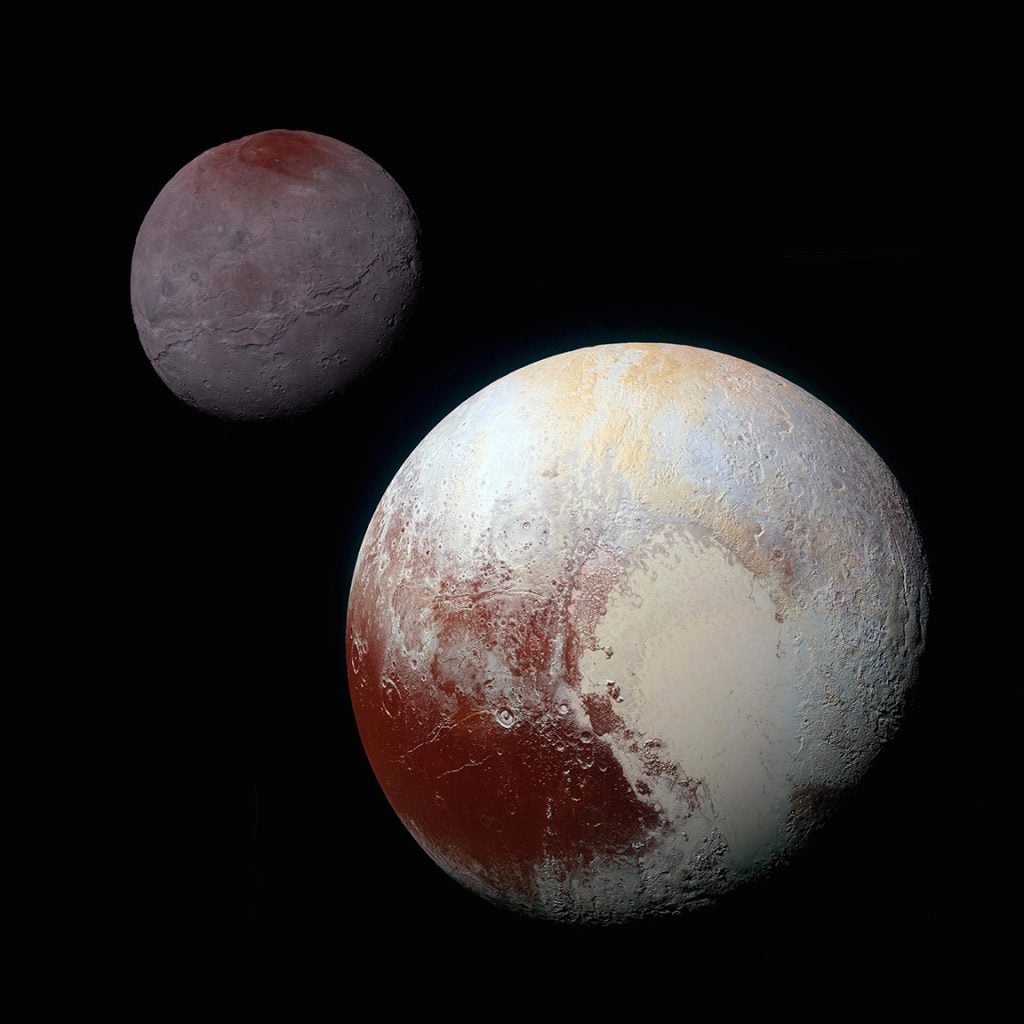The James Webb Space Telescope (JWST) has revealed magnificent things about the Universe. Using its sophisticated infrared optics, it has peered deeper into space (and farther back in time) than any observatory to date, gathering data on the first galaxies to form in our Universe. It has also obtained spectra from exoplanets, revealing things about the chemical composition of their atmospheres. In addition, Webb has provided some stunning views of objects within our Solar System, like Jupiter and its auroras, Saturn's rings and moons, and Neptune and its satellites.
Recently, a team led by researchers from Southwest Research Institute (SwRI) used Webb Near-Infrared Spectrograph (NIRSpec) to closely examine the Pluto-Charon system. Their observations detected frozen carbon dioxide and hydrogen peroxide on the surface of Pluto's largest moon for the first time. These discoveries add to what scientists learned about Charon's chemical inventory from ground-based telescopes and the New Horizons mission. It also reveals more about the chemical composition of the many objects that make up the Kuiper Belt.
The team was led by Silvia Protopapa, a Principal Scientist with the SwRI Department of Space Studies and a co-investigator of the New Horizons* mission. She was joined by members from the Space Telescope Science Institute (STScI), the Florida Space Institute, the Lowell Observatory, the SETI Institute, the Pinhead Institute, the Institut d’Astrophysique Spatiale, the Johns Hopkins University Applied Physics Laboratory (JHUAPL), the Association of Universities for Research in Astronomy (AURA), and NASA Goddard Space Flight Center. The paper that details their findings recently appeared in Nature Communications.*
The observations were part of Webb's Guaranteed Time Observation (GTO) program 1191, which relied on Webb's Near Infrared Camera (NIRCam) to study Kuiper Belt Objects (KBO). Dr. John Stanberry, the program's Principal Investigator, is an instrument scientist for Webb's NIRCam at the Space Telescope Science Institute (STScI). The team used Webb's NIRSpec to conduct four observations of the Pluto-Charon system between 2022 and 2023, which provided full coverage of Charon's northern hemisphere.
Webb spectroscopic measurements revealed signatures of carbon dioxide, which the team compared with laboratory measurements and detailed spectral models of the surface. They concluded that carbon dioxide is present primarily as a surface veneer on a subsurface rich in water ice. As Dr. Protopapa explained in a recent SwRI press release:
"Charon is the only midsized Kuiper Belt object, in the range of 300 to 1,000 miles in diameter, that has been geologically mapped, thanks to the SwRI-led New Horizons mission, which flew by the Pluto system in 2015. Unlike many of the larger objects in the Kuiper Belt, the surface of Charon is not obscured by highly volatile ices such as methane and therefore provides valuable insights into how processes like sunlight exposure and cratering affect these distant bodies. "Our preferred interpretation is that the upper layer of carbon dioxide originates from the interior and has been exposed to the surface through cratering events. Carbon dioxide is known to be present in regions of the protoplanetary disk from which the Pluto system formed."
Hydrogen peroxide forms when water ice is broken down at the atomic level through exposure to ultraviolet light, charged particles from the Sun (solar wind), and galactic cosmic rays. Its presence on the surface of Charon indicates that the water ice-rich surface is subject to photolysis. This is similar to how exposure to solar radiation causes methane to create tholins, which explains why bodies in the outer Solar System are ruddy in appearance. Said SwRI's Dr. Ujjwal Raut, leader of the Cornell Laboratory for Accelerator-based ScienceS and Education (CLASSE) and second author of the paper:
"Laboratory experiments conducted at SwRI's CLASSE (Center for Laboratory Astrophysics and Space Science Experiments) facility were instrumental in demonstrating that hydrogen peroxide can form even in mixtures of carbon dioxide and water ice under conditions analogous to those at Charon."
The team's findings demonstrate Webb's ability to uncover complex surface signatures, which can tell astronomers more about the chemical composition, formation, and evolution of bodies in our Solar System and beyond. These same capabilities allow astronomers to characterize exoplanets' atmospheres to see if they have the necessary ingredients to support life (as we know it).
"The new insights were made possible by the synergy between Webb observations, spectral modeling, and laboratory experiments and are possibly applicable to other similar midsized objects beyond Neptune," said Protopapa.
Further Reading: SWRI*, Nature Communications*
 Universe Today
Universe Today

